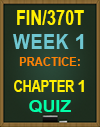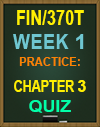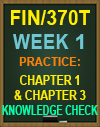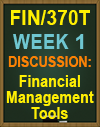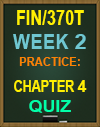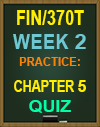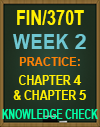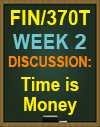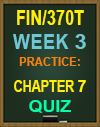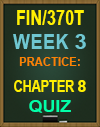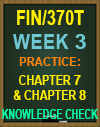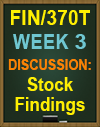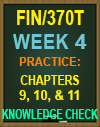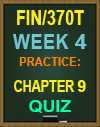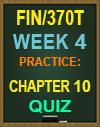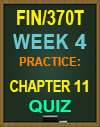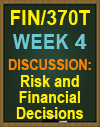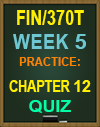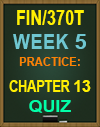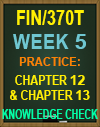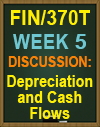FIN/370T Finance for Business |
|
You may also purchase tutorials by the Week below. |
|
|
|
|
|
|
FIN/370T Week 1
FIN/370T Wk 1 Kit Includes:
- Discussion: Financial Management Tools
- Practice: Ch. 1, Introduction to Financial Management
- Practice: Ch. 3, Analyzing Financial Statements
- Practice: Ch. 1 and 3 Knowledge Check
- Apply: Homework
FIN/370T Discussion Question - Financial Management Tools
Includes Discussion Question Response! A+ Work!
Financial management is critically important to the success of any business organization.
Respond to the following in a minimum of 175 words:
- Discuss the role of finance in business. What is the purpose of financial management?
- Describe the kinds of activities that financial management involves.
- What kind of tools do financial managers leverage to access and/or monitor the health and performance of a business? Have you used any of these tools? If so, share your experience.
FIN/370T Week 1 Practice: Chapter 1: Introduction to Financial Management (with correct answers!)
- What result should you expect from firms that make wise financial decisions?
- Which one of the following statements correctly identifies a group that supplies money to the financial markets?
- Which one of these is an investments activity?
- How is risk defined?
- Which of these provides the best description of the difference between accounting and finance?
- True or false: Managerial finance helps managers make decisions related to cash management, capital investments, and risk reduction.
- Which one of these functions is a treasury function?
- Which group has individual investors as participants and is a lender of funds to the financial markets?
- Which of these is an example of a personal financial decision?
- Which of these correctly defines a role of investments?
- Which one of the following best illustrates the definition of a sole proprietorship?
- A discussion of risk in which of the following terms best serves as an overall definition of risk?
- What is the definition of a general partnership?
- True or false: Finance is more concerned about the past while accounting is more concerned about the future.
- Which of these features could accurately be included in the definition of a corporation? Select all that apply.
- Which of the following are finance functions that fall under the supervision of the treasurer? Select all that apply
- Which is the best definition of a hybrid organization?
- Which of these are personal financial decisions? Select all that apply
- Putting the interests of which party first should be the primary goal of a corporation?
- What is the definition of a sole proprietorship?
- A person who works for a firm, but is not necessarily an owner, is called
- Which one of these best defines a general partnership?
- An agency problem is defined as a situation where a firm's managers fail to put the interests of which one of these parties first when making decisions?
- How is a public corporation defined?
- Which one of these best defines corporate governance?
- What are the two key characteristics of a hybrid organization?
- Which of these best defines ethics?
- Which of the following are the well-developed viewpoints that have arisen regarding the goal of a firm? Select all that apply.
- Travis owns a bakery and Mia is a baker. How could an agency relationship exist between these two individuals?
- The profitability of financial market intermediaries depends upon which of these?
- What is the definition of an agency problem?
- The net impact of the lower individual income tax rates brought by TCJA is expected to be (choose all that apply):
- Corporate governance is the set of laws, policies, incentives, and monitors designed to handle issues arising from which one of these?
- True or false: After TCJA, U.S. companies are more likely to "bring home" foreign profits due to the new flat tax rate.
- True or false: Ethics is the study of values, morals, and business judgments.
- Putting the interests of which party first should be the primary goal of a corporation?
- Which of these factors are credited for providing financial institutions with high profit margins?
- One change brought by TCJA is that only the interest on the first $ ________ of mortgage debt is deductible.
- The TCJA established a flat corporate tax rate of:
FIN/370T Week 1 Practice: Chapter 3: Analyzing Financial Statements (with correct answers!)
- Martin's has current assets of $600 and total assets of $2,900. The firm has total debt of $1,500 and long-term debt of $1,100. What is the current ratio?
- Valley Markets has an inventory turnover of 3.2 versus an industry average of 3.5 and a capital intensity ratio of 1.9 versus an industry average of 1.8. What can you determine about the efficiency of Valley Markets?
- True or false: To reduce the number of days' sales held in inventory, a firm needs to decrease the inventory turnover rate.
- PJ's has an average collection period of 42 days as compared to the industry average of 40 days. Which of these statements is supported by this information?
- Oyster Fields has an average payment period of 21 days as compared to its industry average of 33 days. Suppliers in the industry have a 30-day credit policy. Which one of these statements most applies to Oyster Fields?
- The Shoe Store has cash of $300, accounts receivable of $700, accounts payable of $800, inventory of $1,300, long-term debt of $1,900, and notes payable in three months of $500. What is the current ratio?
- Russell's has a fixed asset turnover of 3.1. How do you interpret this information?
- Valley Markets has an inventory turnover of 3.2 and a capital intensity ratio of 1.9. What are the days in inventory for Valley Markets?
- What must the capital intensity ratio be if the total asset turnover rate is 2?
- How is inventory turnover related to days' sales in inventory? Select all that apply.
- Debt management ratios are used to do which of the following? Select all that apply.
- Kelso's has an average collection period of 49 days. How do you interpret this?
- How is a debt ratio of 0.45 interpreted?
- The suppliers of Denver Press offer the firm 30 days credit on all its purchases. Denver Press has an average payment period of 84 days as compared to its industry average of 43 days. Which of these statements applies to Denver Press?
- Last year, Delta's times interest earned ratio was 1.8. This year the ratio is 0.8. How should this change in value be interpreted?
- Petty's has a fixed asset turnover of 2 and a sales to working capital ratio of 4. The industry averages are 1.5 and 3, respectively. Assume all firms in the industry use the same depreciation method and have equipment of similar age. Which one of these statements is correct?
- Assume you are given the values for sales, taxable income, preferred and common stock dividends, interest, and the tax rate. How would you calculate the profit margin?
- Abel's has a total asset turnover rate of 2.2 as compared to its industry average of 1.8. Which one of these might be the cause of Abel's higher rate?
- Two firms have the same amount of assets and equity. Firm A has a market-to-book value of 3.6 compared to 2.9 for Firm B. Which one of these statements is generally correct given this information?
- True or false: The greater the debt the greater the financial leverage
- Which one of these is the best definition of the DuPont system of analysis?
- Buster's has a debt ratio of 1.2. What does this imply?
- ABE Co. has a times interest earned ratio of 3.2. How is this value interpreted?
- The common-size values of both net income and costs of goods sold increased this year over last year. What does this mean?
- A firm has taxes of $2,000, interest expense of $1,000, EBIT of $7,500, common stock dividends of $1,500, and preferred dividends of $1,200. What is the profit margin if sales are $22,000?
- Which one of these formulas correctly defines the retention ratio (RR) for a levered firm with both preferred and common stock?
- The Eatery has a market-to-book ratio of 3.2. What does this ratio indicate?
- True or false: The Corner Store graphs its return on equity by quarter for a running 5-year period. This is time series analysis.
- True or false: The DuPont system of analysis shows how the return on equity is dependent upon the return on assets.
- Which of these is (are) a factor which requires caution when using ratios to evaluate firm performance? Select all that apply.
- The common-size balance sheet value of current assets was 0.21 last year and 0.23 this year. How do you interpret this?
- What is the retention ratio?
- Which one of these best illustrates time series analysis?
- Which of these is (are) a factor which requires caution when using ratios to evaluate firm performance? Select all that apply.
FIN/370T Week 1 Practice: Chapter 1 and Chapter 3 Knowledge Check (with correct answers!)
- Which of the following managers would NOT use finance?
- This is a term to describe non-physical assets like stocks and bonds that get their value from future cash flows.
- Which of the following is defined as a group of securities that exhibit similar characteristics, behave similarly in the marketplace, and are subject to the same laws and regulations?
- This subarea of finance involves methods and techniques to make appropriate decisions about what kinds of securities to own, which firms' securities to buy, and how to be paid back in the form that the investor wishes.
- Methods to minimize agency problem include all EXCEPT
- Which of the following is NOT a function of the board of directors?
- In order for an angel investor or venture capitalist to exchange capital for ownership in a business that is a sole proprietorship, which of these must happen?
- The agency relationship in corporate finance occurs
- When determining a form of business organization, all of the following are considered EXCEPT
- Which of the following do not ensure firm viability over the long run?
- The biggest disadvantage of the sole proprietorship is
- All of the following are an example of a fiduciary relationship EXCEPT
- You are considering a stock investment in one of two firms (A and B), both of which operate in the same industry. A finances its $20 million in assets with $18 million in debt and $2 million in equity. B finances its $20 million in assets with $2 million in debt and $18 million in equity. Calculate the equity multiplier for the two firms.
- Which ratio assesses how efficiently a firm uses its fixed assets?
- Which ratio measures the operating return on the firm's assets irrespective of financial leverage and taxes?
- Which of these ratios show the combined effects of liquidity, asset management, and debt management on the overall operation results of the firm?
- Which ratio measures the overall return on the firm's assets including financial leverage and taxes?
- The maximum growth rate that can be achieved by financing asset growth with internal financing or retained earnings is called the
- According to the list provided in the textbook, which of the following is NOT one of the cautions in using ratios to evaluate firm performance?
- Last year Rain Repel Corporation had an ROA of 5 percent and a dividend payout ratio of 90 percent. What is the internal growth rate?
FIN/370T week 1 Apply Homework (with correct answers!)
- Which of the following is the firm's highest-level financial manager?
- The overall goal of the financial manager is to
- Which of the following can use financial concepts to improve their decisions?
- Which of the following managers would NOT use finance?
- The most common type of business in the United States is the
- Which of the following is NOT a function of the board of directors?
- Methods to minimize agency problem include all EXCEPT
- From the perspective of access to capital, the best form of business organization is the
- This type of business organization is relatively easy to start, and it is subject to much lighter regulatory and paperwork burden than other business forms.
- From a taxation perspective, the form of business organization with the highest business level taxes is the
- Which of the following is NOT considered a hybrid organization?
- In order for an angel investor or venture capitalist to exchange capital for ownership in a business that is a sole proprietorship, which of these must happen?
- Restricted stock is
- Which statements(s) is/are true for successful application of financial theories?
- Tops N Bottoms Corp. reported sales for 2018 of $50 million. Tops N Bottoms listed $4 million of inventory on its balance sheet. Using a 365-day year, how many days did Tops N Bottoms' inventory stay on the premises? How many times per year did Tops N Bottoms' inventory turnover?
- A firm has EBIT of $400,000 and depreciation expense of $20,000. Fixed charges total $50,000. Interest expense totals $7,000. What is the firm's cash coverage ratio?
- Which of the following measures the number of days that the firm holds accounts payable before it has to extend cash to buy raw materials?
- A strong liquidity position means that
- Which of these ratios measure the extent to which the firm uses debt (or financial leverage) versus equity to finance its assets?
- Trina'sTrikes, Inc. reported a debt-to-equity ratio of 2 times at the end of 2018. If the firm's total debt at year-end was $10 million, how much equity does Trina's Trikes have?
- Which ratio measures the number of dollars of operating cash available to meet each dollar of interest and other fixed charges that the firm owes?
- Will's Wheels, Inc. reported a debt-to-equity ratio of 0.65 times at the end of 2018. If the firm's total debt at year-end was $5 million, how much equity does Will's Wheels have?
- Which ratio measures a firm's ability to pay short-term obligations with its available cash and market securities?
- A firm has EBIT of $300,000 and depreciation expense of $12,000. Fixed charges total $44,000. Interest expense totals $7,000. What is the firm's cash coverage ratio?
- A firm has an ROA of 12 percent and an ROE of 52 percent. What is the firm's equity multiplier?
- Tina's Track Supply's market-to-book ratio is currently 4.5 times and PE ratio is 10.5 times. If Tina's Track Supply's common stock is currently selling at $100 per share, what is the book value per share and earnings per share?
- Which of these ratios show the combined effects of liquidity, asset management, and debt management on the overall operation results of the firm?
- The maximum growth rate that can be achieved by financing asset growth with new debt and retained earnings is called the
- All of the following are users of financial ratios EXCEPT
- Last year Poncho Villa Corporation had an ROA of 16 percent and a dividend payout ratio of 25 percent. What is the internal growth rate?
|
|
|
|
|
|
|
FIN/370T Week 2
FIN/370T Week 2 Kit includes:
- Discussion: Time is Money
- Practice: Chapter 4, Time Value of Money 1
- Practice: Chapter 5, Time Value of Money 2
- Practice: Chapter 4 and Chapter 5 Knowledge Check
- Apply: Homework
FIN/370T Week 2 Discussion Question - Time is Money
Includes Discussion Question Response! A+ Work!
We’ve all heard the expression, “Time is money,” and time value of money calculations certainly depict this sentiment.
Respond to the following in a minimum of 175 words:
- Share an example of a situation when you used TVM calculations to support a financial decision either in your professional or personal life. (If necessary, share a hypothetical example of when you might use TVM calculations.)
- Discuss which TVM calculations you used to support your financial decision and the benefits this provided.
- In the example you shared, how was cash flow impacted by your decisions?
FIN/370T Week 2 Practice: Chapter 4: Time Value of Money 1 (with correct answers!)
- Susette invested $10,000 twenty years ago. Ten years ago, she invested an additional $5,000. Last year, she withdrew $8,000 to pay for a vacation. If you were to draw a time line of these events, which value(s) would be treated as a cash inflow(s) to Susette?
- Which one of these correctly defines the future value of a $1,000 investment?
- How is the future value of $500 invested for one year at 6 percent annual interest computed?
- Which one of these is the definition of the compounding of interest?
- Which term is defined as the process of finding a present value by reducing a future value using the applicable rates of interest?
- Five years ago, Lewis Equipment purchased equipment costing $212,000. Two years ago, the firm paid $32,000 for updates to that equipment. This year, the firm sold the equipment for $189,000. Which of these cash flows is (are) cash inflows to Lewis Equipment?
- $100 represents the present value, as it is used in the present value formula, for which of these problems? Select all that apply.
- How is future value best defined?
- You expect to receive a gift of $5,000 six years from today. Which formula provides the value of this gift two years from today if the discount rate is 9 percent?
- Which formula illustrates the value of $100 invested for one year at 5 percent interest?
- Which formula moves a cash flow of $800 ahead six years in time at an interest rate of 5 percent?
- True or false: If you invest $1,000 and earn compound interest, the dollar amount of your annual interest payment will increase each year.
- Ten years ago, you put $5,000 in a savings account. Today, your investment has the purchasing power of $4,800 What is your real rate of return? (just calculate like a normal interest rate)
- Solving which of the following problems illustrates discounting? Select all that apply.
- Which of these is the correct formula for computing the interest rate on an investment?
- Which one of the following is the correct application of the present value formula for this problem: Maria expects to receive $5,000 from her grandmother upon her graduation in three years. What is the current value of this gift if the interest rate is 4 percent?
- How long will it take to double a $2,000 investment at 10% interest
- Charity House has been promised a $25,000 donation five years from today. How much would that gift be worth next year? Assume an interest rate of 8 percent.
- Which formula computes the value in year 9 of a $10,000 investment in year 2 if the interest rate is 6 percent?
- Twelve years ago, you invested $4,800. Today, your investment is worth $8,750. What is your rate of return?
- Sara invested $3,400 six years ago. Today, her investment is worth $4,200. Which formula will correctly compute her rate of return?
- How long will it take to increase a $2,200 investment to $10,000 if the interest rate is 6.5 percent?
FIN/370T Week 2 Practice: Chapter 5: Time Value of Money 2 (with correct answers!)
- Tory invested $600 a year for three years, then $700 a year for an additional four years. In year 9, she withdrew $1,500. She withdrew the entire investment in year 11. Which statement correctly applies to the time line for this problem?
- How is an ordinary annuity defined?
- You have decided to invest for 20 years. You start with $200 a year and plan to increase that amount every three years by an additional $100 a year with the first increase occurring in Year 4. You create a multiple annuity future value time line. What cash flows will appear at Year 7 on the annuity time line?
- True or false: A cash outflow three years from now will appear as a positive value at Year 3 on a present value time line. Assume today is Time 0.
- An annuity pays a rate of 8 percent and has a life of 12 years. Which of these is the correct annuity discount factor for computing a present value of this annuity?
- You plan to invest $300 today and $500 three years from today. Two years from today, you plan to withdraw $50. Which of these is a correct statement regarding a time line for computing the future value of your cash flows four years from today?
- Lester's rented some equipment at a cost of $800 for Years 1 through 3 and $900 for Years 4 and 5. Which of these correctly depicts a portion of the present value of multiple annuities time line?
- Which one of these sets of cash flows fits the description of an ordinary annuity?
- What is a perpetuity?
- You have decided to save $500 a year for the next five years and then increase that amount to $700 a year for the following five years. Which one of these correctly reflects a multiple annuity time line for the future value of your savings?
- Which one of these payment streams fits the definition of an annuity due?
- You expect to receive the following annual cash flows starting at Year 1: $800, $500, $900, and $600. To develop a time line, what will the cash flow for Year 3 be?
- How many times per year is interest compounded on a debt that requires monthly payments?
- An investment will pay $400 a year for 25 years. What is the correct formula to compute the present value of these payments at a rate of 5 percent?
- You expect to receive $600 in Years 1 through 5, $700 in Years 6 through 8, and $400 in Years 9 and 10. What cash flow(s) will appear on a present value of multiple annuities time line for Year 10?
- An investment pays quarterly payments and has an APR of 8 percent. You need to compute the future value at Year 3. What is the calculator input for the interest rate?
- What is the difference between an annuity and a perpetuity?
- Which one of these best defines an annuity due?
- An investment pays an annual rate of 9 percent with interest payments occurring quarterly. How many times per year is the interest compounded?
- A credit card charges an interest rate of one percent per month. Define the annual percentage rate (APR) for this debt.
- Which one of these formulas correctly defines an effective annual rate (EAR) for any compounding period?
- You can afford monthly car payments of $150 for five years at 7 percent. How do you compute the amount you can borrow?
- You borrow money for two years at 1.25 percent per month. How is the effective annual rate (EAR) computed?
- You just borrowed money for four years to buy a car. The payments are $218 a month and the APR is 7 percent. How is the EAR computed?
- Which one of these is the definition of an amortized loan?
- How is the annual percentage rate (APR) defined?
- Identify a true statement about the effective annual rate.
- A 3-year investment pays 5 percent annual interest with semiannual interest payments. How is the EAR computed?
- A loan charges an APR of 11 percent with payments made quarterly. How is the EAR computed?
- You borrow $18,000 for four years to buy a car. The APR is 8 percent. What rate should be used when you compute the monthly payment?
- Which one of these loans meets the definition of an amortized loan?
- A credit card charges an interest rate of one percent per month. Define the annual percentage rate (APR) for this debt.
- What is an amortization schedule?
- You borrowed $16,000 at 8 percent with semiannual payments of $707.23. What is the correct calculator input to compute the time period?
- A $24,000 loan has an interest rate of 9.5 percent and quarterly payments of $936.05. How many years will it take to repay this loan?
- Which statement correctly applies to this monthly loan payment calculation?
- PMT360 = $145,000 × {0.005/[1 - 1/(1 + 0.005)360]} = $869.35
- What is the table called which lists the amount of each loan payment, the interest and principal portions of each payment, and the remaining principal balance?
- A 6 percent, $11,500 car loan requires monthly payments. What rate should be used in the calculator input to determine the number of periods until the loan is repaid in full?
- You pay $366.09 a month on your mortgage. The interest rate is 5 percent and the remaining principal balance is $9,656.21. How long will it be until your mortgage is paid off? (Round your answer to nearest whole number.)
FIN/370T Week 2 Chapter 4 and Chapter 5 Knowledge Check (with correct answers!)
- Which of the following statements is incorrect with respect to time lines?
- Which of the following is NOT true when developing a time line?
- We call the process of earning interest on both the original deposit and on the earlier interest payments
- Approximately what interest rate is needed to double an investment over eight years?
- Approximately how many years does it take to double a $300 investment when interest rates are 8 percent per year?
- Which of the following statements is correct?
- Determine the interest rate earned on a $500 deposit when $650 is paid back in one year.
- You double your money in five years. The reason your return is not 20 percent per year is because:
- Compute the future value in year 4 of a $500 deposit in year 1, and another $1,000 deposit at the end of year 3 using a 5 percent interest rate.
- When saving for future expenditures, we can add the ________ of contributions over time to see what the total will be worth at some point in time.
- What is the present value of a $250 deposit in year 1, and another $50 deposit at the end of year 6 if interest rates are 10 percent?
- If the future value of an ordinary, 4-year annuity is $1,000 and interest rates are 6 percent, what is the future value of the same annuity due?
- If the future value of an ordinary, 5-year annuity is $100,000 and interest rates are 5 percent, what is the future value of the same annuity due?
- Many people who want to start investing for their future want to start today, which implies an annuity stream that is paid at the beginning of the period. Beginning-of-period cash flows are referred to as
- Compounding monthly versus annually causes the interest rate to be effectively higher, and thus the future value
- A loan is offered with monthly payments and a 6.5 percent APR. What is the loan's effective annual rate (EAR)?
- When you get your credit card bill, if you make a payment larger than the minimum payment
- The simple form of an annualized interest rate is called the annual percentage rate (APR). The effective annual rate (EAR) is a
- People refinance their home mortgages
- When you get your credit card bill, it will offer a minimum payment, which
FIN/370T Week 2 Apply Homework (Note: Step by Step Explanation is included to show you how to solve the problems) (with correct answers!)
- We call the process of earning interest on both the original deposit and on the earlier interest payments
- What is the future value of $2,000 deposited for one year earning 6 percent interest rate annually?
- You are offered a choice between $770 today and $815 one year from today. Assume that interest rates are 4 percent. Which do you prefer?
- What is the future value of $1,000 deposited for one year earning 5 percent interest rate annually?
- How much would be in your savings account in 7 years after depositing $100 today if the bank pays 5 percent interest per year?
- If an average home in your town currently costs $300,000, and house prices are expected to grow at an average rate of 5 percent per year, what will an average house cost in 10 years?
- People borrow money because they expect
- What is the present value of a $600 payment in one year when the discount rate is 8 percent?
- What is the present value of a $7,000 payment made in six years when the discount rate is 4 percent?
- Approximately what interest rate is needed to double an investment over six years?
- Approximately what interest rate is needed to double an investment over four years?
- Compute the present value of $3,000 paid in four years using the following discount rates: 3 percent in year 1, 4 percent in year 2, 5 percent in year 3, and 6 percent in year 4.
- How are present values affected by changes in interest rates?
- Approximately how many years does it take to double a $500 investment when interest rates are 4 percent per year?
- You double your money in five years. The reason your return is not 20 percent per year is because:
- Determine the interest rate earned on an $800 deposit when $808 is paid back in one year.
- Determine the interest rate earned on a $450 deposit when $475 is paid back in one year.
- Level sets of frequent, consistent cash flows are called
- When saving for future expenditures, we can add the ________ of contributions over time to see what the total will be worth at some point in time.
- What is the future value of a $500 annuity payment over eight years if interest rates are 14 percent?
- What is the future value of an $800 annuity payment over 15 years if the interest rates are 6 percent?
- What is the future value of a $1,000 annuity payment over 4 years if the interest rates are 8 percent?
- Your credit rating and current economic conditions will determine
- If the future value of an ordinary, 11-year annuity is $5,575 and interest rates are 5.5 percent, what is the future value of the same annuity due?
- If the present value of an ordinary, 8-year annuity is $12,500 and interest rates are 9.1 percent, what is the present value of the same annuity due?
- If the future value of an ordinary, 4-year annuity is $1,000 and interest rates are 6 percent, what is the future value of the same annuity due?
- Many people who want to start investing for their future want to start today, which implies an annuity stream that is paid at the beginning of the period. Beginning-of-period cash flows are referred to as
- A loan is offered with monthly payments and a 14.5 percent APR. What is the loan's effective annual rate (EAR)?
- When you get your credit card bill, it will offer a minimum payment, which
- A loan is offered with monthly payments and a 10 percent APR. What is the loan's effective annual rate (EAR)?
|
|
|
|
|
|
|
| FIN/370T Week 3
FIN/370T Week 3 Kit includes:
- Discussion: Stock Findings
- Practice: Chapter 7, Valuing Bonds
- Practice: Chapter 8, Valuing Stocks
- Practice: Ch. 7 and Ch. 8 Knowledge Check
- Apply: Homework
FIN/370T Week 3 Discussion Question - Stock Findings
Includes Discussion Question Response! A+ Work!
At any point in time, the market value of a firm’s common stock depends on many factors.
Respond to the following in a minimum of 175 words:
- Visit Yahoo Finance. Select a public company that has not been selected by another student in the discussion and look up the company’s stock’s performance over the last year. Discuss which company you selected and its performance.
- What do you think are the market forces that might have influenced the value of the company’s stock at its peaks and valleys?
- What do your findings indicate about your selected company’s financial health?
FIN/370T Week 3 Practice: Chapter 7: Valuing Bonds
- Which statement related to bonds is true?
- Which one of these correctly defines a bond feature?
- Speculative bonds are frequently referred to as which type of bonds?
- Assume a $1,000 Treasury inflation-protected bond has a 2 percent coupon and a face value at issuance of $1,000. The reference CPI is 202.34 and the current CPI is 203.18. What do you know for certain about this bond?
- Which one of these characteristics designates a premium bond?
- Which of these statements is correct?
- True or false: The financial status of the issuer will affect the coupon rate that issuer pays on its bonds.
- Which of these are common features of a corporate bond? Select all that apply.
- Which one of these terms indicates a bond is unsecured?
- Which one of these descriptions defines a Treasury inflation-protection security (TIPS)?
- Which of these characteristics apply to a discount bond? Select all that apply.
- What is the price of a $100,000 par value U. S. Treasury security if the price quote is 102.1446?
- Which of the following affect the coupon rate a firm must set on its bonds if the bonds are to be sold at par? Select all that apply.
- Which one of these correctly defines a bond feature?
- The market rate of interest that is used to compute the present value of a bond is affected by which of the following? Select all that apply.
- What is a zero coupon bond?
- Assume a $1,000 Treasury inflation-protected bond has a 2 percent coupon and a face value at issuance of $1,000. The reference CPI is 202.34 and the current CPI is 203.18. What do you know for certain about this bond?
- Corporate bond A has a 6 percent coupon and matures in 3 years. Corporate bond B has a 6 percent coupon and matures in 15 years. The current interest rate is 6 percent. By how much will Bond A and Bond B change in price if the market rate increases to 6.5 percent? Assume both bonds are currently selling at par which is $1,000.
- How much will you pay to purchase a $100,000 U. S. Treasury bond that is quoted at 99.6250?
- True or false: If you buy a bond today at par value and sell it one year from today, also at par value, the rate of return you will earn will equal to current yield.
- True or false: The financial status of the issuer will affect the coupon rate that issuer pays on its bonds.
- Which one of the following should be used to compare various corporate bonds if you plan to purchase a bond today, hold it until maturity, and want to select the bond with the highest rate of return?
- Which of these best explains the current value of a bond?
- How does the yield to call differ from the yield to maturity for the same bond? Select all that apply.
- Which one of these is the best description of a 5-year zero coupon bond?
- Assume a corporate bond pays a 5 percent coupon and matures in ten years. What will be the change in the current price of this bond if market interest rates increase from 5 to 5.5 percent?
- Which one of these correctly defines equivalent taxable yield?
- Which one of these is the current yield formula?
- A corporate bond has a current yield of 6.39 percent and a price quote of 97.8. What is the coupon rate?
- What is the definition of yield to maturity?
- What is the definition of credit quality risk?
- Which one of these defines the yield to call?
- What is the yield spread?
- Which one of these formulas correctly computes the equivalent taxable yield?
- Which of these statements correctly applies to the NYSE bond market? Select all that apply.
- A 7.5 percent corporate bond matures in 16 years and has a price quote of 102.3. What is the yield to maturity?
- What is a common means of reporting the daily direction of overall bond price movements?
- What does a bond rating measure?
- A 10-year Treasury bond has a 4 percent coupon and a yield to maturity of 4.62 percent. A 10-year, A-rated corporate bond has a 4.5 percent coupon and a yield to maturity of 5.98 percent. What is the yield spread between these two bonds?
- Most secondary trades in the U. S. bond market occur between which two parties?
- Which of the following are sources of information on the bond markets? Select all that apply.
FIN/370T Week 3 Practice: Chapter 8: Valuing Stocks
- Which of these apply to publicly-issued common stock? Select all that apply.
- How important is the liquidity provided by stock exchanges to the equity markets?
- A stock quote displays the last price as 28.13, down 0.10. What was the previous day's closing price?
- A(n) ___________ symbol is the unique code for a company on a stock exchange. It consists of one to five letters.
- If you purchase shares of stock on NASDAQ, who is the most likely seller of those shares?
- Which of these descriptions apply to common stock? Select all that apply.
- Which of these is the key service provided by stock exchanges that attracts investors?
- What is the definition of market capitalization?
- A stock quote shows a P/E of 18. How is the ratio defined?
- ___________, located around the perimeter of the floor of the stock exchange, act as agents for those buying and selling stocks
- Which of these services should you expect to receive from a full-service brokerage firm? Select all that apply.
- Which of these terms best describes the trading process used by NASDAQ?
- Which of these is correct?
- The value of a firm as measured by its market capitalization is solely dependent upon the market value of the firm's stock.
- Which statements are correct? Select all that apply.
- Which one of the following characteristics most applies to a discount brokerage firm?
- Which one of these applies to stock valuation?
- A dealer will buy stock from an investor at the ask price.
- What is the key premise upon which the dividend discount model is based?
- What is the definition of market capitalization?
- Mary placed an order to purchase 100 shares of ABC stock at the going price. The order was filled as soon as it reached the floor of the exchange. What type of order did Mary place?
- Which one of these generally applies to preferred stock?
- How is the discount rate used to evaluate a security related to the security's level of risk?
- Which one of these defines the current value of a stock?
- Which one of these best defines the dividend discount model?
- Which of these are basic assumptions of a variable growth rate valuation? Select all that apply.
- The value of a firm as measured by its market capitalization is solely dependent upon the market value of the firm's stock.
- A P/E is a measure of relative value.
- A preferred stock has which of these characteristics?
- How is the discount rate used to value a stock related to the expected return on the stock? Assume the stock price fairly reflects the stock's value.
- What is the primary purpose of the P/E valuation formula?
- A firm is expected to have net earnings of $4.00 per share of stock outstanding. The firm's current P/E ratio is 14 and it is expected to remain at that level. What is the firm's expected stock price for year 2?
- What is the best definition of the variable-growth rate stock valuation method?
- Which of these is a correct interpretation of a P/E ratio?
- If you want to estimate a future price, Pn, using the P/E valuation formula, you should use the estimated earnings for which year?
- A firm is expected to have net earnings of $1,480,000 three years from now. There are 500,000 shares of stock outstanding. The firm's current P/E ratio is 18 and it is expected to remain at that level. What is the firm's expected stock price for year 3?
- Which of these is a correct interpretation of a P/E ratio?
FIN/370T Week 3 Chapter 7 and Chapter 8 Knowledge Check
- Regarding a bond's characteristics, which of the following is the principal loan amount that the borrower must repay?
- To increase the liquidity for the home mortgage market, Fannie Mae and Freddie Mac purchased home mortgages from banks and other lenders. They combined the mortgages into diversified portfolios of loans and issued
- A bond issued by a corporation on May 1, 1999, is scheduled to mature on May 1, 2019. If today is May 2, 2009, what is this bond's time to maturity? (Assume annual interest payments.)
- Which of these statements answers why bonds are known as fixed income securities?
- Which of the following is NOT true about EE savings bonds?
- Which of the following issues Treasury Inflation Protected Securities (TIPS)?
- A 4.5 percent corporate coupon bond is callable in five years for a call premium of one year of coupon payments. Assuming a par value of $1,000, what is the price paid to the bondholder if the issuer calls the bond?
- Which of the following terms is a comparison of market yields on securities, assuming all characteristics except maturity are the same?
- What is the taxable equivalent yield on a municipal bond with a yield to maturity of 4 percent for an investor in the 28 percent tax bracket?
- Which of the following is an important advantage to the issuer of a bond with a call provision?
- The bond's annual coupon rate divided by its market price is referred to as the
- The NASDAQ Composite includes
- The Dow Jones Industrial Average (DJIA) includes
- Which of the following is an electronic stock market without a physical trading floor?
- Why is the ask price higher than the bid price?
- If a preferred stock from Ecology and Environment, Inc. (EEI) pays $2.50 in annual dividends, and the required return on the preferred stock is 5.8 percent, what's the value of the stock?
- Which of the following will only be executed if the order's price conditions are met?
- Stock valuation model dynamics make clear that higher growth rates lead to
- We can estimate a stock's value by
- International Business Machines (IBM) has earnings per share of $6.85 and a P/E ratio of 15.19. What is the stock price?
FIN/370T Week 3 Apply Homework
Note: Includes Step-by-Step instructions on how to solve the problems = A+ Work!
- Determine the semi-annual interest payment for the following three bonds: 5.5 percent coupon corporate bond, 6.45 percent coupon Treasury note, and a corporate zero-coupon bond maturing in 10 years. (Assume a $1,000 par value.)
- Regarding a bond's characteristics, which of the following is the principal loan amount that the borrower must repay?
- A bond issued by a corporation on May 1, 1999, is scheduled to mature on May 1, 2019. If today is May 2, 2009, what is this bond's time to maturity? (Assume annual interest payments.)
- Which of the following is NOT true about EE savings bonds?
- Which of these statements answers why bonds are known as fixed income securities?
- The interest rate used to compute the bond’s interest payment each year refers to:
- A 3.75 percent TIPS has an original reference CPI of 175.8. If the current CPI is 207.7, what is the current interest payment and par value of the TIPS? (Assume semiannual interest payments and $1,000 par value.)
- To compensate the bondholders for getting the bond called, the issuer pays which of the following?
- Which of the following statement(s) below is true regarding asset-backed securities?
- Which of the following is a debt security whose payments originate from other loans, such as credit card debt, auto loans, and home equity loans?
- Bond prices are quoted in terms of which of the following?
- Which of the following bonds makes no interest payments?
- Calculate the price of a zero-coupon bond that matures in 20 years if the market interest rate is 8.5 percent. (Assume annual compounding and a par value of $1,000.)
- What is the taxable equivalent yield on a municipal bond with a yield to maturity of 4 percent for an investor in the 28 percent tax bracket?
- What's the current yield of a 6 percent coupon corporate bond quoted at a price of 101.70?
- Which of these investors earn returns from receiving dividends and from stock price appreciation?
- Trading at physical exchanges like the New York Stock Exchange and the American Stock Exchange takes place
- The Dow Jones Industrial Average (DJIA) includes
- Individuals who use their own stock inventory and capital to buy and sell the stocks they represent are called
- GEN has 10 million shares outstanding and a stock price of $89.25. What is GEN's market capitalization?
- All of the following are stock market indices EXCEPT
- Which of the following is an electronic stock market without a physical trading floor?
- At your discount brokerage firm, it costs $9.95 per stock trade. How much money do you need to buy 100 shares of Ralph Lauren (RL), which trades at $85.13?
- Which of these are valued as a special zero-growth case of the constant growth rate model?
- You would like to buy shares of International Business Machines (IBM). The current bid and ask quotes are $103.25 and $103.30, respectively. You place a market buy-order for 200 shares that executes at these quoted prices. How much money did it cost to buy these shares?
- If Target Corp. (TGT) recently earned a profit of $6.07 earnings per share and has a P/E ratio of 16.5. The dividend has been growing at a 10 percent rate over the past few years. If this growth continues, what would be the stock price in five years if the P/E ratio remained unchanged? What would the price be if the P/E ratio increased to 18 in five years?
- The size of the firm measured as the current stock price multiplied by the number of shares outstanding is referred to as the firm's
- You would like to buy shares of International Business Machines (IBM). The current bid and ask quotes are $96.17 and $96.24, respectively. You place a market buy-order for 100 shares that executes at these quoted prices. How much money did it cost to buy these shares?
- A firm does not pay any dividends at this point in time. Which valuation method should be used on this stock?
- Ultra Petroleum (UPL) has earnings per share of $1.75 and P/E of 42.56. What is the stock price?
|
|
|
|
|
|
|
|
| FIN/370T Week 4
FIN/370T Week 4 Kit includes:
- Discussion: Risk and Financial Decisions
- Practice: Ch. 9, Characterizing Risk and Return
- Practice: Ch. 10, Estimating Risk and Return
- Practice: Ch. 11, Calculating the Cost of Capital
- Practice: Ch. 9, 10, and 11 Knowledge Check
- Apply: Homework
FIN/370T Week 4 Discussion Question - Risk and Financial Decisions
Includes Discussion Question Response! A+ Work!
Investors need to know how much risk they have to take to confidently expect a certain percentage return. Likewise, managers want to know what return shareholders require so that they can decide how to meet those expectations.
Respond to the following in a minimum of 175 words:
- Select 2–3 of the topics below and discuss how they each influence financial decisions regarding risk and return:
- The capital asset pricing model (CAPM)
- The constant–growth model
- Compute forward-looking expected return and risk
- Risk premiums
FIN/370T Week 4 Practice: Chapter 9: Characterizing Risk and Return
- What type of relationship exists between risk and expected return?
- How is the term "dollar return" defined?
- How can you best describe the relationship between the performance of long-term
- Treasury bonds and the S&P 500 during the period 2000-2012?
- What does standard deviation measure?
- Based on actual performance for the period 1950-2017, which one of the following
- displayed the least amount of risk and why? Select the best answer.
- What is the relationship between risk and return?
- Risk, as it is used in the coefficient of variation (CoV), is best defined as a measure of which one of these?
- The dollar return on a stock investment includes which of these?
- What type of risk exists in a fully-diversified portfolio?
- The S&P 500 had the highest decade average return for which period?
- How is standard deviation defined in relation to investments?
- What is firm-specific risk?
- Based on annual returns for the years 2000-2012, which one of the following exhibited the greatest risk and why?
- What is the definition of the coefficient of variation?
- Stock investors cannot avoid which type of risk?
- What is the primary focus of modern portfolio theory (MPT)?
- Which of these defines correlation?
- Which one of these is the correct formula for computing the return on a portfolio
- comprised of unequal amounts of stocks A, B, and C?
- How is the total dollar return on a stock investment calculated?
- Risk, as it is used in the coefficient of variation (CoV), is best defined as a measure of which one of these?
- How is correlation defined?
- What is the relationship between risk and return?
- The dollar return on a stock investment includes which of these?
- Which of these best summarizes market performance for the period 1950-2012?
- How is standard deviation defined in relation to investments?
- Based on annual returns for the years 2000-2012, which one of the following exhibited the greatest risk and why?
FIN/370T Week 4 Practice: Chapter 10: Estimating Risk and Return
- Which of these illustrates the definition of a probability distribution?
- How is required return defined?
- Asset pricing can be described as which type of process?
- Which one of these best illustrates a probability distribution at it relates to next year's economy?
- Which one of these variables is used to measure compensable risk in the capital asset pricing model (CAPM)?
- Which one of these is the most effective means of lowering the beta of a portfolio?
- Which one of these is commonly used as a proxy for the market portfolio?
- How is the range of beta values defined for a portfolio of risky assets? Select all that apply.
- What is the definition of an efficient market?
- Which one of these defines the efficient market hypothesis (EMH)?
- Which one of these formulas correctly computes the return required by an investor?
- How is a stock market bubble defined?
FIN/370T Week 4 Practice: Chapter 11: Calculating the Cost of Capital
- What does a firm-wide WACC represent?
- What are the three sources of external capital for a firm?
- Why must the cost of debt be adjusted for taxes?
- A firm has a capital structure of 40% common stock, 10% preferred stock, and 50%
- debt. A new project is being internally funded. What weight should be used for equity in the project WACC?
- What condition must a new project meet if the project is to qualify to use the firm's
- WACC as the project's WACC?
- The yield to maturity on a firm's bonds is 8.8 percent. What is the component cost of debt if the tax rate is 35 percent?
- Assume a firm takes on a new project that is much riskier than the firm's existing
- projects. Which party disproportionately bears this new risk?
- Why must the cost of debt be adjusted for taxes?
- Which variable most needs adjusting when revising a firmwide WACC into a divisional WACC?
- When computing a divisional WACC, a proxy value is needed for which one of these?
- What is the subjective approach to divisional WACCs?
- What are flotation costs?
- How can business risk be defined?
- How are flotation costs incorporated into the constant-growth formula for computing the cost of equity?
FIN/370T Week 4 Practice: Chapter 9, Chapter 10, and Chapter 11 Knowledge Check
Note: Includes Step-by-Step instructions on how to solve the problems = A+ Work!
-
Sprint Nextel Corp. stock ended the previous year at $25.00 per share. It paid a $2.57 per share dividend last year. It ended last year at $18.89. If you owned 650 shares of Sprint, what was your dollar return and percent return?
-
Sharif's portfolio generated returns of 10 percent, 9 percent, −2 percent, and 6 percent over four years. What was his average return over this period?
- Which of the following statements is correct?
- Which of these is defined as a combination of investment assets held by an investor?
- Rank the following three stocks by their risk-return relationship, best to worst. Rail Haul has an average return of 10 percent and standard deviation of 15 percent. The average return and standard deviation of Idol Staff are 15 percent and 25 percent; and of Poker-R-Us are 12 percent and 35 percent.
- Which of the following is defined as the portion of total risk that is attributable to firm or industry factors and can be reduced through diversification?
- An investor owns $2,000 of Adobe Systems stock, $4,000 of Dow Chemical, and $6,000 of Office Depot. What are the portfolio weights of each stock?
- Determine which one of these three portfolios dominates another. Name the dominated portfolio and the portfolio that dominates it. Portfolio Blue has an expected return of 14 percent and risk of 19 percent. The expected return and risk of portfolio Yellow are 15 percent and 18 percent; and for the Purple portfolio are 16 percent and 21 percent.
- Which of the following is typically considered the return on U.S. government bonds and bills and equals the real interest plus the expected inflation premium?
- The annual return on the S&P 500 Index was 12.4 percent. The annual T-bill yield during the same period was 5.7 percent. What was the market risk premium during that year?
- A company has a beta of 3.75. If the market return is expected to be 20 percent and the risk-free rate is 9.5 percent, what is the company's required return?
- Whenever a set of stock prices go unnaturally high and subsequently crash down, the market experiences what we call a(n)
- You have a portfolio with a beta of 0.9. What will be the new portfolio beta if you keep 40 percent of your money in the old portfolio and 60 percent in a stock with a beta of 1.5?
- Paccar's current stock price is $75.10 and it is likely to pay a $3.29 dividend next year. Since analysts estimate Paccar will have a 14.2 percent growth rate, what is its required return?
- A company's current stock price is $65.40 and it is likely to pay a $2.25 dividend next year. Since analysts estimate the company will have an 11.25 percent growth rate, what is its expected return?
- Which of these makes this a true statement? The WACC formula
- IVY has preferred stock selling for 98 percent of par that pays a 7 percent annual coupon. What would be IVY's component cost of preferred stock?
- The reason that we do not use an after-tax cost of preferred stock is
- Any debt and preferred stock components of capital should
- An estimated WACC computed using some sort of proxy for the average equity risk of the projects in a particular business unit is known as the
FIN/370T Week 4 Apply Homework Quiz
Note: Includes Step-by-Step instructions on how to solve the problems = A+ Work!
- Which statement is true?
- WayCo stock was $75 per share at the end of last year. Since then, it paid a $3 per share dividend last year. The stock price is currently $70. If you owned 200 shares of WayCo, what was your percent return?
- Rank the following three stocks by their level of total risk, highest to lowest. Rail Haul has an average return of 8 percent and standard deviation of 10 percent. The average return and standard deviation of Idol Staff are 10 percent and 20 percent; and of Poker-R-Us are 6 percent and 15 percent.
- Which of the following is defined as the volatility of an investment, which includes firm specific risk as well as market risk?
- Sharif's portfolio generated returns of 12 percent, 15 percent, −15 percent, 19 percent, and −12 percent over five years. What was his average return over this period?
- Which of these is the dollar return characterized as a percentage of money invested?
- TechNo stock was $25 per share at the end of last year. Since then, it paid a $1.50 per share dividend last year. The stock price is currently $23. If you owned 300 shares of TechNo, what was your percent return?
- The optimal portfolio for you will be
- Which of the following is an index that tracks 500 companies, which allows for a great deal of diversification?
- Year-to-date, Oracle had earned a 15.0 percent return. During the same time period, Valero Energy earned −12.96 percent and McDonald's earned 1.80 percent. If you have a portfolio made up of 50 percent Oracle, 10 percent Valero Energy, and 40 percent McDonald's, what is your portfolio return?
- Year-to-date, Company O had earned a −2.10 percent return. During the same time period, Company V earned 8.00 percent and Company M earned 6.25 percent. If you have a portfolio made up of 40 percent Company O, 30 percent Company V, and 30 percent Company M, what is your portfolio return?
- Which of these is the reward for taking systematic stock market risk?
- Compute the expected return given these three economic states, their likelihoods, and the potential returns:
- Which of the following is a true statement?
- If the risk-free rate is 8 percent and the market risk premium is 2 percent, what is the required return for the market?
- The annual return on the S&P 500 Index was 18.1 percent. The annual T-bill yield during the same period was 6.2 percent. What was the market risk premium during that year?
- Which of these is the set of probabilities for all possible occurrences?
- Which of these is a measure of the sensitivity of a stock or portfolio to market risk?
- In theory, which of these is a combination of securities that places the portfolio on the efficient frontier and on a line tangent from the risk-free rate?
- Hastings Entertainment has a beta of 1.24. If the market return is expected to be 10 percent and the risk-free rate is 4 percent, what is Hastings' required return?
- ABC Inc. has a dividend yield equal to 5 percent and is expected to grow at a 12 percent rate for the next seven years. What is ABC's required return?
- Paccar's current stock price is $75.10 and it is likely to pay a $3.29 dividend next year. Since analysts estimate Paccar will have a 14.2 percent growth rate, what is its required return?
- Which of the following will directly impact the cost of equity?
- Apple's 9 percent annual coupon bond has 10 years until maturity and the bonds are selling in the market for $890. The firm's tax rate is 21 percent. What is the firm's after-tax cost of debt?
- When firms use multiple sources of capital, they need to calculate the appropriate discount rate for valuing their firm's cash flows as
- When calculating the weighted average cost of capital, weights are based on
- JackITs has 5 million shares of common stock outstanding, 1 million shares of preferred stock outstanding, and 20 thousand bonds. If the common shares are selling for $28 per share, the preferred shares are selling for $13.50 per share, and the bonds are selling for 98 percent of par, what would be the weight used for common stock in the computation of JackITs' WACC?
- Sports Corp. has 10 million shares of common stock outstanding, 5 million shares of preferred stock outstanding, and 1 million bonds. If the common shares are selling for $25 per share, the preferred shares are selling for $12.50 per share, and the bonds are selling for 97 percent of par, what would be the weight used for common stock in the computation of Sports' WACC?
- The reason that we do not use an after-tax cost of preferred stock is
- An estimated WACC computed using some sort of proxy for the average equity risk of the projects in a particular business unit is known as the
|
|
|
|
|
|
|
FIN/370T Week 5
FIN/370T Week 5 Kit includes:
- Discussion
- Practice: Ch. 12, Estimating Cash Flows on Capital Budgeting
- Practice: Ch. 13, Weighing Net Present Value and Other…
- Practice: Ch. 12 and 13 Knowledge Check
- Apply: Homework
FIN/370T Week 5 Discussion Question - Depreciation and Cash Flows
Includes Discussion Question Response! A+ Work!
Estimating cash flows isn’t difficult, but it is complicated, as there are a lot of little details to keep track of. Having a systematic approach to handling and arranging details is key to successful finance management and advancing organizational goals.
Respond to the following in a minimum of 175 words:
- Discuss a business example that shows how depreciation and accelerated depreciation can affect project cash flows.
- What would your process be to ensure that all related financial details are allocated for and tracked so as to assist in making sound business decisions?
FIN/370T Week 5 Practice: Chapter 12: Estimating Cash Flows on Capital Budgeting
- What is pro forma analysis?
- What is an incremental cash flow?
- Which of these represent opportunity costs? Select all that apply.
- What is a sunk cost?
- How is a complementary effect defined?
- In proforma analysis, what determines whether or not an account on the balance sheet or income statement is relevant to a project?
- How can you determine if a cash flow is incremental to a project? Select all that apply.
- Which one of these represents an opportunity cost?
- How can a sunk cost be recovered?
- Which of these is the best description of the substitution effect?
- Which of these are financing costs? Select all that apply.
- What are the key differences between the free cash flows of a firm and those of a project? Select all that apply.
- What types of costs are included in an asset's depreciable basis? Select all that apply.
- Which one of these is a correct formula for OCF, assuming there is no interest expense?
- Which one of these represents a time zero project cash flow?
- What is a financing cost?
- Free cash flows for which one of the following are affected by estimation error?
- McGinty's purchased a new machine for $318,000, paid $19,000 in sales tax, and $7,500 in delivery charges. The firm paid $3,400 to have the machine calibrated once it was set in place. The machine requires $5,600 of annual maintenance. What is the depreciable basis of the machine?
- How is operating cash flow (OCF) defined?
- Manor's purchases some equipment in preparation for a new project. Which of these are time zero cash flows for that project? Select all that apply.
- If you add all the cash flows related to net working capital (NWC) over a project's life, what sum must you obtain if your cash flows are correct?
- A project has a 3-year life and requires equipment costing $34,000. The OCF is estimated at $16,000 annually. NWC of $3,500 is required over the project's life. What cash flows occur at time zero? Select all that apply.
- The half-year convention is based on which of these assumptions?
- What is the double-declining balance (DDB) method of depreciation?
- How do Section 179 deductions aid small businesses?
- A project has a 3-year life and annual sales projections of $120,000, $160,000 and $190,000 for years 1 to 3, respectively. The project requires net working capital (NWC) equal to 5 percent of the next year's sales. How is this requirement handled in project analysis? Select all that apply.
- A new project requires $24,000 of equipment which will be depreciated straight-line to zero over the project's 4-year life. The project requires $2,400 of NWC, the annual OCF is $16,000, and the tax rate is 35 percent. The equipment's market value at the end of year 4 is $5,000. What cash flows occur in year 4? Select all that apply.
- Over how many tax years will a 3-year asset be depreciated given the half-year convention?
- What does accelerated depreciation indicate?
- Which one of these represents a limit placed on Section 179 deductions?
- An asset is 5-year MACRS property and has an initial cost of $64,200. The MACRS percentages are: 20, 32, 19.2, 11.52, 11.52, and 5.76 percent for years 1 to 6, respectively. What is the book value at the end of year 4?
- A project requires $15,000 of net working capital throughout its 5-year life. How is this requirement handled in project analysis? Select all that apply.
- A firm has an existing asset with a book value of $6,600 and annual depreciation of $2,200. Assume this asset is replaced with a new asset costing $15,400. The new asset will be depreciated straight-line over its 5-year life. What is the incremental depreciation for year 4?
- Which of these correctly define free cash flow? Select all that apply.
- An asset has a depreciable basis of $13,200 and qualifies as 3-year MACRS property. The MACRS percentages are: 16.67, 33.33, 33.33. and 16.67 percent for years 1 to 4, respectively. What is the year 3 ending book value?
- Which of these conditions generally occur in situations where equivalent annual cost (EAC) applies as the method of decision making? Select all that apply.
- Why are a firm's target capital structure values used in computing the average flotation cost?
- A firm has an existing asset with a book value of $6,600 and annual depreciation of $2,200. Assume this asset is replaced with a new asset costing $15,400. The new asset will be depreciated straight-line over its 5-year life. What is the incremental depreciation for year 2?
- How is free cash flow defined?
- Which one of these is a key assumption in situations where EAC is used as the decision method?
- What is the first step in the process of adjusting the initial investment for flotation costs?
- Assume the initial costs of a project, CF0, are $38,000 and the weighted average flotation cost, fA, is 6.7 percent. How is the flotation-adjusted CF0 computed?
FIN/370T Week 5 Practice: Chapter 13: Weighing Net Present Value and Other...
- What type of return are firms seeking when considering a real asset project?
- True or false: For most projects, net present value is the generally preferred method for making capital budgeting decisions.
- Rate-based decision statistics are popular because managers like to compare the expected rate of return to which one of these?
- What does the term "mutually exclusive projects" imply?
- Which of these apply to the payback method? Select all that apply.
- Why do firms purchase real assets in the form of capital equipment?
- Which one of these is the primary advantage of the payback method?
- Rate-based decision statistics provide a rate of return based on which one of these?
- Which one of these is the primary advantage of the payback method?
- A project has been assigned a maximum allowable payback period of 2.5 years. How is the reject decision expressed for this project?
- When is a cash flow not discounted when using the discounted payback method for project analysis?
- What should the decision be if the maximum allowable discount period is less than the discounted payback (DPB) statistic?
- Which one of these is a weakness of the payback method?
- Which one of these correctly states the accept rule for the payback statistic?
- What does the net present value (NPV) of a project represent?
- What is the discounted payback method designed to compute?
- A project has an initial cost of $1,800 and cash flows of $700, $1,100, and $900 for years 1 to 3, respectively. The discount rate is 8 percent. Should the project be accepted or rejected according to discounted payback (DPB) if the maximum allowable period is two years?
- In the NPV formula, what does CF0 represent?
- Which of these is a weakness of the payback method? Select all that apply.
- What is the definition of net present value (NPV)?
- What value should be used to discount the cash flow that occurs in time period N when computing a net present value?
- Which one of these statements is correct?
- Which one of these is an advantage of the net present value (NPV) method?
- What is the internal rate of return (IRR)?
- What is the accept decision rule for discounted payback (DPB)?
- In the NPV formula, what does CF0 represent?
- Why is the IRR formula set equal to zero?
- What does a positive net present value (NPV) represent?
- Explain the disadvantage of the net present value (NPV) method.
- Which of these defines the internal rate of return (IRR)? Assume the cash flows are normal. Select all that apply.
- How can the IRR benchmark best be described?
- To solve for the IRR statistic, set NPV equal to___________
- A project has cash flows of -$400, $200, $200, -$100, $300, and -$50. How many x-axis intersection points will the NPV profile for this project have?
- Which one of these statements is correct?
- What is the internal rate of return (IRR)?
- A project is acceptable if it graphs at the x-axis intersection point on a NPV profile graph. Where else can the project graph and be acceptable? Assume normal cash flows.
- Which one of these is the IRR benchmark?
- Why should the internal rate of return (IRR) not be used as the decision technique for projects with non-normal cash flows?
- How are non-normal cash flows modified for MIRR purposes? Select all that apply.
- Given a set of normal cash flows, which shape does the NPV profile have?
- You are considering two mutually exclusive projects, A and B. Which of these options do you have? Select all that apply.
- Which of these are strengths of the MIRR process? Select all that apply.
- Which of these requires modification so MIRR can be applied to non-normal cash flows?
- The NPV profile graphs NPV as a function of what?
- How can the profitability index (PI) be defined?
- You are considering three mutually exclusive projects. Which one of these options is immediately eliminated as a possible decision?
- Which one of these is a weakness of MIRR?
- How are non-normal cash flows modified for MIRR purposes? Select all that apply.
- Which of these project PI's indicate a reject decision? Select all that apply.
- What do you know for certain about PI if the NPV is positive and non-zero?
- What is the profitability index (PI) accept rule?
- The profitability index (PI) is most closely associated with which other decision method?
FIN/370T Week 5 Practice: Chapter 12 and Chapter 13 Knowledge Check
- As new capital budgeting projects arise, we must estimate
- Equipment was purchased for $250,000 plus $500 in freight charges. Installation costs were $750 and sales tax totaled $18,750. Hiring a special consultant to provide advice during the selection of the equipment cost $500. What is this asset's depreciable basis?
- Equipment was purchased for $100,000 plus $1,000 in freight charges. Installation costs were $500 and sales tax totaled $7,500. Hiring a special consultant to provide advice during the selection of the equipment cost $1,000. What is this asset's depreciable basis?
- If a firm has already paid an expense or is obligated to pay one in the future, regardless of whether a particular project is undertaken, that expense is a
- To correctly project cash flows, we need to consider all of the factors EXCEPT
- Suppose you sell a fixed asset for $75,000 when its book value is $80,000. If your company's marginal tax rate is 21 percent, what will be the effect on cash flows of this sale (i.e., what will be the after-tax cash flow of this sale)?
- With regard to depreciation, the time value of money concept tells us that
- Which statement is true regarding cost-cutting proposals?
- Your company is considering a new project that will require $250,000 of new equipment at the start of the project. The equipment will have a depreciable life of eight years and will be depreciated to a book value of $10,000 using straight-line depreciation. The cost of capital is 12 percent, and the firm's tax rate is 21 percent. Estimate the present value of the tax benefits from depreciation.
- You are trying to pick the least expensive car for your new delivery service. You have two choices: the Scion xA, which will cost $13,000 to purchase and which will have OCF of −$1,200 annually throughout the vehicle's expected life of three years as a delivery vehicle; and the Toyota Prius, which will cost $23,000 to purchase and which will have OCF of −$550 annually throughout that vehicle's expected five-year life. Both cars will be worthless at the end of their life. If you intend to replace whichever type of car you choose with the same thing when its life runs out, again and again out into the foreseeable future, and if your business has a cost of capital of 16 percent, what is the difference in the EAC of the two cars?
11. Compute the payback statistic for Project X and recommend whether the firm should accept or reject the project with the cash flows shown as follows if the appropriate cost of capital is 10 percent and the maximum allowable payback is five years.
Time: |
0 |
1 |
2 |
3 |
4 |
5 |
Cash flow: |
−75 |
−75 |
0 |
100 |
75 |
50 |
12. Compute the payback statistic for Project X and recommend whether the firm should accept or reject the project with the cash flows shown as follows if the appropriate cost of capital is 9 percent and the maximum allowable payback is four years.
Time: |
0 |
1 |
2 |
3 |
4 |
5 |
Cash flow: |
−1,000 |
−75 |
100 |
100 |
0 |
2,000 |
13. When choosing between two mutually exclusive projects using the payback period method for evaluating capital projects, one would choose
14. Compute the NPV for Project X with the cash flows shown as follows if the appropriate cost of capital is 10 percent.
Time |
0 |
|
1 |
|
2 |
|
3 |
|
4 |
Cash Flow |
–$ |
100,000 |
|
|
$ |
36,000 |
|
|
$ |
200,000 |
|
|
$ |
210,000 |
|
|
$ |
10,000 |
|
|
15. Compute the NPV statistic for Project X given the following cash flows if the appropriate cost of capital is 12 percent. Project X
Time |
0 |
|
1 |
|
2 |
|
3 |
|
4 |
Cash Flow |
–$ |
15,000 |
|
|
$ |
6,000 |
|
|
$ |
10,000 |
|
|
$ |
12,000 |
|
|
–$ |
1,000 |
|
|
16. All of the following are strengths of payback EXCEPT
17. Which of these is a capital budgeting technique that generates decision rules and associated metrics for choosing projects based upon the implicit expected geometric average of a project's rate of return?
18. Compute the PI statistic for Project X and note whether the firm should accept or reject the project with the cash flows shown as follows if the appropriate cost of capital is 10 percent.
Time: |
0 |
1 |
2 |
3 |
4 |
5 |
Cash flow: |
−75 |
−75 |
0 |
100 |
75 |
50 |
19. Which of the following is a capital budgeting technique that converts a project's cash flows using a more consistent reinvestment rate prior to applying the internal rate of return, IRR, decision rule?
20. Which rate-based decision statistic measures the excess return (the amount above and beyond
FIN/370T Week 5 Apply Homework
- Suppose you sell a fixed asset for $112,000 when its book value is $112,000. If your company's marginal tax rate is 21 percent, what will be the effect on cash flows of this sale (i.e., what will be the after-tax cash flow of this sale)?
- Equipment was purchased for $50,000 plus $2,500 in freight charges. Installation costs were $1,500 and sales tax totaled $1,000. Hiring a special consultant to provide advice during the selection of the equipment cost $3,000. What is this asset's depreciable basis?
- Effects that arise from a new product or service that decrease sales of the firm's existing products or services are referred to as
- If a firm has already paid an expense or is obligated to pay one in the future, regardless of whether a particular project is undertaken, that expense is a
- Suppose you sell a fixed asset for $99,000 when its book value is $129,000. If your company's marginal tax rate is 21 percent, what will be the effect on cash flows of this sale (i.e., what will be the after-tax cash flow of this sale)?
- Coke is planning on marketing a new drink called Very Berry Coke which is a mixture of raspberry and blackberry flavors blended to perfection and added to the highly secret Coca-Cola formula. This new product is expected to reduce the sales of their existing product, Cherry Coke, by $10 million per year. This is an example of a
- The research chemists at MegaClean created a new cleaner that keeps car and truck tires shiny and clean for one year. They believe that this product will be highly successful and will attract customers to purchase their existing line of household cleaning products. This is an example of
- The process of estimating expected future cash flows of a project using only the relevant parts of the balance sheet and income statements is referred to as
- AB Mining Company just commissioned a firm to identify if an unused portion of their mine contains any silver or gold at a cost of $125,000. This is an example of a(n)
- As new capital budgeting projects arise, we must estimate
- Your company is considering a new project that will require $250,000 of new equipment at the start of the project. The equipment will have a depreciable life of eight years and will be depreciated to a book value of 10,000 using straight-line depreciation. The cost of capital is 12 percent, and the firm's tax rate is 21 percent. Estimate the present value of the tax benefits from depreciation.
- Your company is considering a new project that will require $2,000,000 of new equipment at
the start of the project. The equipment will have a depreciable life of 10 years and will be depreciated to a book value of $250,000 using straight-line depreciation. The cost of capital is 12 percent, and the firm's tax rate is 21 percent. Estimate the present value of the tax benefits from depreciation.
- Accelerated depreciation allows firms to
- You are trying to pick the least expensive car for your new delivery service. You have two choices: the Scion xA, which will cost $13,000 to purchase and which will have OCF of −$1,200 annually throughout the vehicle's expected life of three years as a delivery vehicle; and the Toyota Prius, which will cost $23,000 to purchase and which will have OCF of −$550 annually throughout that vehicle's expected five-year life. Both cars will be worthless at the end of their life. If you intend to replace whichever type of car you choose with the same thing when its life runs out, again and again out into the foreseeable future, and if your business has a cost of capital of 16 percent, what is the difference in the EAC of the two cars?
15. Compute the discounted payback statistic for Project Y and recommend whether the firm should accept or reject the project with the cash flows shown as follows if the appropriate cost of capital is 12 percent and the maximum allowable discounted payback is three years.
Time: |
0 |
1 |
2 |
3 |
4 |
5 |
Cash flow: |
−5,000 |
500 |
2,000 |
3,000 |
1,500 |
500 |
16. Compute the NPV statistic for Project Y given the following cash flows and if the appropriate cost of capital is 12 percent. Project Y
Time |
0 |
|
1 |
|
2 |
|
3 |
|
4 |
|
5 |
Cash Flow |
–$ |
10,000 |
|
|
$ |
3,000 |
|
|
$ |
4,000 |
|
|
$ |
1,000 |
|
|
$ |
2,000 |
|
|
$ |
500 |
|
17. Which of the following statements is correct?
18. Which of the following is a technique for evaluating capital projects that tells how long it will take a firm to earn back the money invested in a project?
19. The net present value decision technique may not be the only pertinent unit of measure if the firm is facing
20. Compute the NPV for Project X with the cash flows shown as follows if the appropriate cost of capital is 9 percent.
Time: |
0 |
1 |
2 |
3 |
4 |
5 |
Cash flow: |
−1,000 |
−75 |
100 |
100 |
0 |
2,000 |
21. Compute the NPV statistic for Project X given the following cash flows if the appropriate cost of capital is 10 percent. Project X
Time |
0 |
|
1 |
|
2 |
|
3 |
|
4 |
Cash Flow |
–$ |
100,000 |
|
|
–$ |
36,000 |
|
|
$ |
200,000 |
|
|
$ |
210,000 |
|
|
–$ |
10,000 |
|
|
22. A capital budgeting technique that generates a decision rule and associated metric for choosing projects based on the total discounted value of their cash flows is referred to as
23. Compute the NPV statistic for Project Y given the following cash flows if the appropriate cost of capital is 10 percent. Project Y
Time |
0 |
|
1 |
|
2 |
|
3 |
|
4 |
|
5 |
Cash Flow |
–$ |
50,000 |
|
|
$ |
7,000 |
|
|
$ |
20,000 |
|
|
$ |
20,000 |
|
|
$ |
20,000 |
|
|
$ |
10,000 |
|
24. All of the following are strengths of payback EXCEPT
25. A decision rule and associated methodology for converting the NPV statistic into a rate-based metric is referred to as
26. Compute the PI statistic for Project Z and advise the firm whether to accept or reject the project with the cash flows shown as follows if the appropriate cost of capital is 10 percent. Project Z
Time |
0 |
|
1 |
|
2 |
|
3 |
|
4 |
|
5 |
Cash Flow |
–$ |
1,000 |
|
|
$ |
350 |
|
|
$ |
380 |
|
|
$ |
420 |
|
|
$ |
300 |
|
|
$ |
100 |
|
|
27. Compute the IRR statistic for Project X and note whether the firm should accept or reject the project with the cash flows shown as follows if the appropriate cost of capital is 10 percent.
Time: |
0 |
1 |
2 |
3 |
4 |
5 |
Cash flow: |
−75 |
−75 |
0 |
100 |
75 |
50 |
28. Compute the IRR for Project X and note whether the firm should accept or reject the project with the cash flows shown as follows if the appropriate cost of capital is 9 percent.
Time: |
0 |
1 |
2 |
3 |
4 |
5 |
Cash flow: |
−1,000 |
−75 |
100 |
100 |
0 |
2,000 |
29. Which rate-based decision statistic measures the excess return (the amount above and beyond the cost of capital for a project), rather than the gross return?
30. Compute the PI statistic for Project X and note whether the firm should accept or reject the project with the cash flows shown as follows if the appropriate cost of capital is 10 percent.
Time: |
0 |
1 |
2 |
3 |
4 |
5 |
Cash flow: |
−75 |
−75 |
0 |
100 |
75 |
50 |
|




